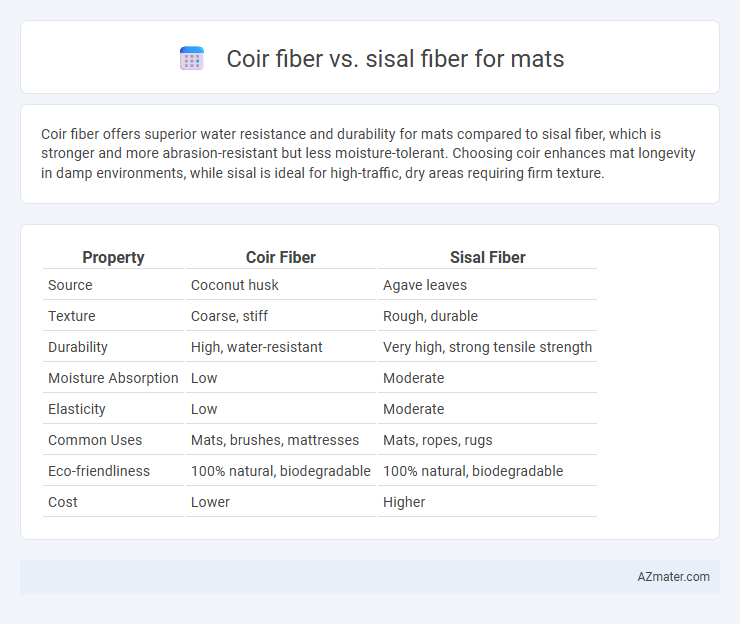Coir fiber offers superior water resistance and durability for mats compared to sisal fiber, which is stronger and more abrasion-resistant but less moisture-tolerant. Choosing coir enhances mat longevity in damp environments, while sisal is ideal for high-traffic, dry areas requiring firm texture.
Table of Comparison
| Property | Coir Fiber | Sisal Fiber |
|---|---|---|
| Source | Coconut husk | Agave leaves |
| Texture | Coarse, stiff | Rough, durable |
| Durability | High, water-resistant | Very high, strong tensile strength |
| Moisture Absorption | Low | Moderate |
| Elasticity | Low | Moderate |
| Common Uses | Mats, brushes, mattresses | Mats, ropes, rugs |
| Eco-friendliness | 100% natural, biodegradable | 100% natural, biodegradable |
| Cost | Lower | Higher |
Introduction to Coir and Sisal Fibers
Coir fiber, derived from the outer husk of coconut shells, is a coarse and durable natural fiber widely used in mats for its water resistance and cushioning properties. Sisal fiber, extracted from the Agave sisalana plant, is known for its strength, flexibility, and biodegradability, making it ideal for eco-friendly mat production. Both fibers offer unique advantages in durability and texture, with coir favoring moisture resistance and sisal emphasizing softness and sustainability.
Origin and Source of Coir and Sisal
Coir fiber is derived from the outer husk of coconut shells, predominantly harvested in tropical regions like India, Sri Lanka, and the Philippines, where coconut palms thrive. Sisal fiber originates from the leaves of the Agave sisalana plant, mainly cultivated in countries such as Brazil, Tanzania, and Kenya, known for their arid and semi-arid climates. The distinct botanical sources and geographic origins influence the durability and texture of mats made from these natural fibers.
Physical Properties Comparison
Coir fiber exhibits higher tensile strength, greater water resistance, and superior durability compared to sisal fiber, making it ideal for heavy-duty mats in humid environments. Sisal fiber offers better stiffness and a coarser texture, which provides excellent abrasion resistance but lower elasticity than coir. Both fibers have distinct characteristics; coir's high lignin content enhances resilience, whereas sisal's cellulose abundance contributes to its firmness and biodegradability in mat applications.
Durability and Strength Analysis
Coir fiber exhibits superior durability and resilience compared to sisal fiber due to its higher lignin content, making it ideal for mats exposed to heavy wear and moisture. Sisal fiber offers greater tensile strength, providing enhanced resistance to tearing and deformation under stress, but it is less resistant to prolonged exposure to water. Mats made from coir fiber are favored in outdoor or high-traffic environments for their long-lasting performance, while sisal mats excel in indoor settings requiring robust, strong, yet lighter materials.
Water Resistance and Maintenance
Coir fiber offers superior water resistance compared to sisal fiber, making it ideal for mats exposed to moisture or outdoor conditions. Sisal fiber tends to absorb water, which can lead to mold and quicker wear, requiring more frequent maintenance. Regular cleaning and drying are essential for sisal mats to prevent damage, whereas coir mats generally require less upkeep due to their natural resilience to water.
Environmental Impact and Sustainability
Coir fiber, derived from coconut husks, is highly biodegradable, renewable, and requires minimal chemical processing, making it an eco-friendly choice for mats. Sisal fiber, obtained from the Agave plant, is also biodegradable and renewable but demands more water and pesticides during cultivation, potentially increasing its environmental footprint. Both fibers offer sustainable alternatives to synthetic materials, yet coir fiber generally boasts a lower carbon footprint and better waste utilization in production.
Comfort and Texture Differences
Coir fiber mats offer a coarse, rough texture that provides excellent durability and support but may feel stiff underfoot, making them less comfortable for prolonged contact. Sisal fiber mats, on the other hand, boast a smoother, more flexible texture that enhances softness and comfort, suitable for areas where barefoot walking is frequent. The natural resilience of sisal fibers results in a gentler surface, whereas coir's rigid structure prioritizes longevity over cushioned comfort.
Cost Comparison: Coir vs Sisal Mats
Coir mats generally cost less than sisal mats due to the abundant availability and lower processing expenses of coconut husk fibers. Sisal mats, made from agave plant fibers, tend to be pricier because of more intensive extraction and manufacturing processes. Consumers often choose coir mats for budget-friendly options while selecting sisal mats for durability and premium texture despite higher prices.
Best Applications for Each Fiber
Coir fiber, derived from coconut husks, is highly durable, water-resistant, and ideal for outdoor mats, ingress mats, and doormats exposed to heavy foot traffic and moisture. Sisal fiber, obtained from the agave plant, offers flexibility, breathability, and natural abrasion resistance, making it perfect for indoor mats, area rugs, and decorative floor coverings in low-moisture environments. The choice depends on environmental conditions and usage intensity, with coir favored for rugged, wet areas and sisal suited for dry, aesthetically focused applications.
Conclusion: Choosing the Right Fiber for Your Mat
Coir fiber offers superior durability and water resistance, making it ideal for outdoor mats and high-traffic areas, while sisal fiber provides a softer texture and natural aesthetic, perfect for indoor mats with moderate use. Consider your environment and mat usage to select the optimal fiber, balancing durability, comfort, and appearance. Quality and maintenance requirements also influence the long-term performance of coir and sisal fiber mats.

Infographic: Coir fiber vs Sisal fiber for Mat
 azmater.com
azmater.com